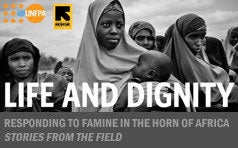News
One Mother Delivers Triplets in Safety: Others are Not So Lucky
- 07 October 2011
News
This is one of a series of features UNFPA is producing about the life in the camps where hundreds of thousands of people have sought refuge from war and famine in the Horn of Africa. The stories document the lives, the loss, the hopes and the fears of some of the most disenfranchised people in the world today.
GARISSA, Kenya — While Hawa Ali, a 27-year-old mother of nine, was pregnant with triplets, Garissa Provincial Hospital in Northern Kenya became her second home.
For nearly four months, the Kenyan woman stayed at the maternity shelter within the hospital on recommendations of health workers at the facility. An examination established that she was carrying twins and was too frail to continue carrying the babies without close medical supervision.
On 15 September, she delivered two boys and a girl through Caesarean section. They were small – under six pounds each – but otherwise in good shape.

“What really helped me is the milk they give me. My husband has many problems. He only sells charcoal, and he has other wives,” Hawa explained. Because her children couldn’t be provided for while she was at the hospital, six of them stayed with her in the ward. “The children are also given food, porridge and tea. That’s great help, as the drought was too much,” she explained.
Dozens of other expecting mothers weakened by lack of proper diets are also staying at the shelter, under the watchful eyes of the staff. Most of them come from remote places where there is limited or no access to medical care. The hospital administration came up with the idea of a maternity shelter to ensure that these women receive the support they need before their pregnancy and during the delivery.
“Most of the mothers we care for are pregnant with twins or triplets,” explained Dr. Almal Alshabibi, the hospital’s Deputy medical superintendent. “They are very weak and need special medical care.”
Female genital mutilation/cutting, a tradition widely practiced among Somali communities, also complicates many deliveries. “Many mothers suffer tears when they deliver, which may cause the woman to bleed to death,” added Dr. Alshabibi. The traditional form of FGM/C in the region is the most extreme form, which typically includes sewing up the vaginal walls, and often disrupts sexual, reproductive and urinary functions for life.
Following the birth of her last three children, Hawa and her husband were counselled by UNFPA’s partners about voluntary family planning methods. Hawa chose to use long-term family planning through the use of implants.
“If you plan your family, you are able to take better care of yourself and your children,” Hawa said.
For UNFPA’s Executive Director, Dr. Babatunde Osotimehin, who met Hawa during a visit to the region last month, the provision of family planning services is a priority. “We need to think about how we can better educate people about the different choices that can be offered to them and increase the uptake of family planning methods in the region,” he explained.
Hawa was fortunate enough to get supervised care prior to her risky delivery. But many others are not so lucky.
Due to the scarcity of health facilities in Northern Kenya, and the urgent need to support pregnant women, UNFPA’s partners such as the Kenyan Red Cross have been providing training to traditional birth attendants living in remote communities. These birth attendants may be able to identify some risky pregnancies, and try to get them to the Garissa hospital.
One of women who received training was Abshira Mohammed, 42. After losing four of her own children during childbirth, she wanted to do something to help others. “I should have seven children now,” says Abshira Mohamed, 42, who lives in a thatch hut in the village of Abakaile, about 350 km north of Kenya’s capital, Nairobi. “But only three survived.”
“There are no hospitals here,” she explains. “Women have nowhere to go if they want to give birth.” The nearest hospital, in Garissa, is about 50 km away. Travelling there is a torturous journey through dust, scorching heat and cattle tracks that serve for roads. Due to lack of transport networks and hospitals, many mothers deliver at home without proper care.
“I have seen many women who need to go to hospital, but they just deliver here in the bush without any help,” Abshira says. According to the Kenya Demographic and Health Survey released by the government, only 44 per cent of women giving birth in Kenya were attended by a skilled provider between 2008 and 2009. The figure is much higher in the northern part of the country.
The Kenyan Red Cross has been distributing UNFPA’s clean delivery kits to help mothers and traditional birth attendants in case of emergency deliveries. The kits include gloves, plastic sheeting, and a sterilized razor to cut the umbilical cord. It also contains a towel and a shawl to keep the newborn warm. These items can help to reduce infection among both mother and baby, and thus save lives.
While these kits may be helpful in uncomplicated deliveries, when complications, such as obstructed labour, haemorrhage and eclampsia, arise, skilled birth attendants and emergency obstetric assistance are often required to save the lives of mothers and infants.
— Patrick Mathangani